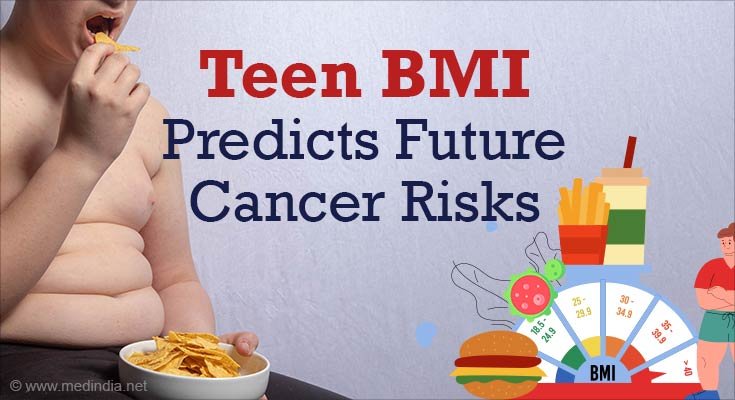Higher BMI in Youth Impacts Future Cancer Risks

High BMI at the time of conscription was linked to an increased risk of 17 malignancies, including lung, head and neck, brain, thyroid, esophageal, stomach, pancreatic, liver, colon, rectal, kidney, and bladder cancer, as well as malignant melanoma, leukemia, myeloma, and lymphoma (both Hodgkin’s and non-Hodgkin’s).
For several cancer types, the risk was already enhanced with a BMI of 20-22.4, which is within the normal weight range (18.5-24.9). Cancers of the head and neck, esophagus, stomach, pancreas, liver, and kidney were among them, as were malignant melanoma and non-Hodgkin’s lymphoma.
“This suggests that the current definition of normal weight may be applicable primarily for older adults, while an optimal weight as a young adult is likely to be in a lower range. Our research group has drawn similar conclusions regarding BMI in early adulthood and later cardiovascular disease,” says Maria Åberg, professor of family medicine at Sahlgrenska Academy at the University of Gothenburg and senior author.
Prostate Cancer is the Most Diagnosed Cancer in Men With Normal Weight
Prostate cancer was more likely among those who were neither overweight nor obese at the time of enlistment, deviating from the pattern. One possible explanation is that men of normal weight are more likely to seek treatment for prostate issues, resulting in more early healthcare interactions and diagnoses.
Childhood Obesity Linked to 3-4 Times Higher Risk of Cancer
The relationship between obesity and abdominal malignancies was strongest for cancers of the esophagus, stomach, and kidney, with obese men having a three to four times greater risk at enrolment. An unhealthy weight appeared to explain roughly 15-25% of these cancer incidences.
Advertisement
The researchers predict an increase in the proportion of cancer cases connected to childhood obesity in 30 years, based on the proportion of overweight and obesity among today’s 18-year-old men in Sweden. The proportion climbs to 32% for stomach cancer and 37% for esophageal cancer. Based on the present frequency of childhood overweight and obesity in the United States, high BMI in the late adolescent years could be associated with more than one in every two cases of these two cancers in 30 years.
Aron Onerup is a postdoctoral researcher at Sahlgrenska Academy at the University of Gothenburg and the first author of the study at St. Jude Children’s Research Hospital in Memphis, Tennessee.
Pressing Need to Address Childhood Obesity
“Overweight and obese at a young age seem to increase the risk of developing cancer, and we see links between unhealthy weight and cancer in almost every organ. Given the alarming trend of obesity in childhood and adolescence, this study reinforces the need to deploy strong resources to reverse this trend,” he says.
The researchers predict an increase in the proportion of cancer cases connected to childhood overweight and obesity in 30 years, based on the proportion of overweight and obesity among today’s 18-year-old men in Sweden. The proportion climbs to 32% for stomach cancer and 37% for esophageal cancer. Based on the present frequency of childhood overweight and obesity in the United States, high BMI in the late adolescent years could be associated with more than one in every two cases of these two cancers in 30 years.
Aron Onerup is a postdoctoral researcher at Sahlgrenska Academy at the University of Gothenburg and the first author of the study at St. Jude Children’s Research Hospital in Memphis, Tennessee.
Higher BMI = Increased Mortality
The researchers also investigated mortality rates in this group following cancer diagnosis. During the follow-up period, 84,621 of the 1,489,115 males studied who enrolled in Sweden between 1968 and 2005 were diagnosed with some kind of cancer.
Men who were overweight or obese were shown to be 2-3 times more likely to die within five years after being diagnosed with skin cancer, Hodgkin’s lymphoma, thyroid, bladder, and prostate cancer, and 1.4-2 times more likely to die from head and neck, rectum, and kidney cancer.
References:
- Good fitness levels in youth linked to lower cancer risk
https://www.gu.se/en/news/good-fitness-levels-in-youth-linked-to-lower-cancer-risk - Associations between BMI in youth and site-specific cancer in menA cohort study with register linkage
https://doi.org/10.1002/oby.23942 - Cardiorespiratory fitness and BMI measured in youth and 5-year mortality after site-specific cancer diagnoses in menA population-based cohort study with register linkage
https://doi.org/10.1002/cam4.6553
Source: Medindia
Source link
#Higher #BMI #Youth #Impacts #Future #Cancer #Risks



